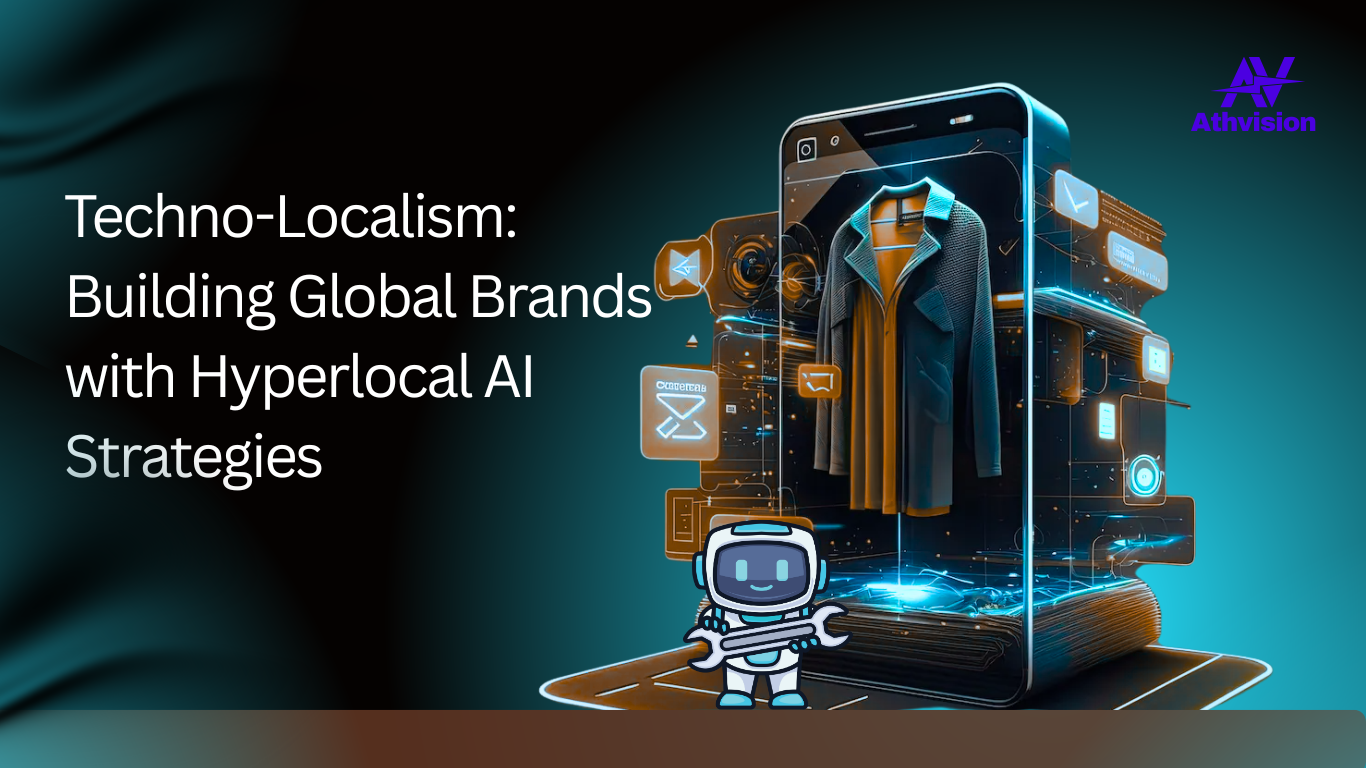In a world more connected than ever before, brands face a paradox: how to maintain global reach while creating local relevance. Enter Techno-Localism—a transformative approach that fuses cutting-edge technologies, especially AI, with hyperlocal strategies. Instead of treating the world as one homogenized market, Techno-Localism empowers brands to speak authentically to individual communities, aligning global ambitions with local nuances.
What Is Techno-Localism?
Techno-Localism is more than just advanced localization or translation. It’s the strategic use of AI, data analytics, and machine learning to design experiences, campaigns, and products that are culturally and contextually specific. Through this approach, global brands shift from broadcasting generic messages to engaging in tailored, culturally relevant conversations at the neighborhood level. AI becomes more than a tool—it’s the translator, strategist, and cultural bridge.
Why Techno-Localism Matters
Today’s digital landscape is saturated with content, yet users increasingly crave authenticity. People engage with brands that speak their language—literally and figuratively. AI enables this by processing language, sentiment, tone, and culture-specific nuances at scale. Technologies like natural language processing (NLP), computer vision, and generative AI now make it possible to understand and respond to hyperlocal preferences almost instantaneously.
Moreover, the global economy is moving toward decentralization. Supply chain disruptions, inflation, and geopolitical shifts have accelerated the return to local production and community-driven commerce. In this climate, brands that adopt a Techno-Localist approach are more adaptable and resilient.
The Pillars of Techno-Localism
At the core of Techno-Localism lies hyperlocal data. Brands can leverage geo-tagged social media posts, local search trends, regional sentiment analysis, micro-influencer engagement, and even real-time weather or traffic data to drive localized decision-making. For instance, an AI-powered fashion retailer might promote raincoats in Mumbai during monsoon season while featuring sunglasses in Cairo—all based on hyperlocal weather insights.
AI also allows for culturally sensitive content adaptation. Tools like GPT and BERT can translate idioms, adjust humor, and even suggest regionally appropriate visuals—from fashion and architecture to color schemes. Imagine an AI designing a Ramadan-themed campaign for the Middle East while crafting a Diwali-centric version for India, all while maintaining brand consistency.
Personalization is another cornerstone. AI systems analyze local behavior patterns to predict what specific communities want—even before they ask. A grocery chain might learn that a certain district prefers plant-based milk in summer, prompting timely promotions that feel less like marketing and more like service.
And thanks to generative AI platforms like Canva, Adobe Firefly, and OpenAI’s tools, local teams can produce high-quality visuals, captions, and scripts on demand—ensuring that content is both brand-consistent and hyper-relevant without bottlenecks at corporate HQ.
Techno-Localism in Action
Coca-Cola’s “Real Magic” campaign is a prime example. By using AI to analyze social listening data from over 80 countries, the company created regionally tailored messages that resonated deeply. Similarly, Netflix uses AI to greenlight and promote shows based on regional viewing habits, producing hits like Korean dramas, Spanish thrillers, and Nigerian comedies. Nike, meanwhile, taps into local subcultures—streetwear in Tokyo, running in Nairobi—creating micro-campaigns that feel custom-made for every community.
A New Era of Brand Building
Branding has evolved from static logos and slogans to dynamic ecosystems of experience and interaction. Social media, AI, and digital tools have democratized brand building, giving power back to communities. A 2024 McKinsey report found that brands implementing hyperlocal strategies see an average 20% boost in engagement—a clear sign that local relevance is a competitive advantage, not a constraint.
This shift demands a new framework. Techno-Localism revolves around five principles: Purpose, People, Community, Conversations, and Connections.
First, everything starts with purpose. A brand’s mission must guide not just its messaging, but its actions and engagement. In one startup I co-founded, we initially struggled with a vague purpose. It wasn’t until we refocused on empowering local artisans through sustainable products—and used AI to find aligned communities—that our marketing finally resonated.
Second, Techno-Localism treats people as individuals, not as target demographics. Tools like Spotify’s Discover Weekly show how AI can deliver deeply personal experiences based on unique preferences and habits.
Third, community trumps content. Brands like LEGO have built loyal followings by fostering creative spaces like LEGO Ideas, where customers co-create and feel heard.
Fourth, conversations replace campaigns. During my time with a consumer tech firm, we ditched one-way marketing blasts and focused on two-way social media conversations—resulting in a 35% jump in engagement within six months.
Finally, connections are holistic. Brands like Nike create seamless experiences across platforms—from apps to stores to social media. This omnichannel integration ensures every touchpoint tells a cohesive story.
The Techno-Localism Playbook
To put Techno-Localism into action, brands should follow a few essential steps:
Start by clearly defining your brand’s purpose, using AI to analyze market sentiment and refine your messaging. Then, identify your people—use data to build detailed cultural and behavioral profiles. Next, map the communities aligned with your mission, both online and offline. Build a conversation engine—whether that’s a dedicated social media team or AI chatbots that can respond with local flavor. And finally, ensure your brand’s experience is seamless across platforms, using AI to track and optimize user journeys.
The Trade-Offs of Techno-Localism: Understanding the Advantage, Disadvantage, and Benefits
As Techno-Localism continues to redefine the future of brand building, it’s essential to take a clear-eyed look at what this approach offers—and what challenges it brings. Like any transformative strategy, Techno-Localism presents a mix of compelling strengths and potential pitfalls.
The Core Advantage: Deep Cultural Resonance at Scale
The most powerful advantage of Techno-Localism is its ability to deliver deeply relevant, culturally resonant experiences across diverse markets—without sacrificing scale. In the past, creating tailored campaigns for each local market required massive resources, time, and dedicated teams. With the advent of AI, brands can now localize content, tone, imagery, and strategy in real time, reaching communities not as part of a monolithic audience but as distinct cultural ecosystems.
For example, an international skincare brand can use AI to analyze local weather patterns, skin-type preferences, and language nuances in Southeast Asia to create personalized product recommendations and advertising for each region—all while maintaining brand consistency. This level of cultural relevance strengthens customer trust, increases emotional connection, and boosts long-term brand loyalty.
The Key Disadvantage: Risk of Cultural Missteps and Data Ethics
Despite its promise, Techno-Localism also comes with inherent risks. One major concern is the potential for cultural misinterpretation or stereotyping. While AI can process vast amounts of data, it still lacks human empathy and intuition. If left unchecked, automated content may unintentionally reinforce clichés or miss critical nuances, especially in sensitive contexts involving religion, identity, or tradition.
Moreover, the strategy’s reliance on hyperlocal data raises legitimate privacy concerns. To build personalized experiences, brands often need access to granular data like geolocation, browsing history, and user behavior. If this data collection isn’t transparent, ethical, and compliant with regulations like GDPR or CCPA, it can erode consumer trust rather than build it.
Therefore, brands must strike a careful balance—using AI to scale hyperlocal strategies while ensuring human oversight, cultural intelligence, and strong ethical safeguards.
The Benefits: What Techno-Localism Brings to the Table
When implemented thoughtfully, Techno-Localism unlocks a range of business and brand benefits:
- Increased Consumer Engagement: Personalized content that reflects local values, language, and behaviors leads to higher interaction rates. Consumers are far more likely to engage with messaging that feels authentic and tailored to their world.
- Higher Brand Loyalty and Emotional Connection: By addressing the unique needs of communities, brands foster deeper emotional connections. Customers don’t just see a product—they see a brand that understands and respects their culture.
- Faster Go-To-Market Capability: AI-driven localization accelerates campaign development. Instead of months of preparation, companies can launch hyper-targeted campaigns in days, responding to local trends and events in near real time.
- Improved Resource Efficiency: Centralized AI tools reduce the need for sprawling regional content teams while still empowering local marketers with the autonomy to adapt messaging. This blend of central efficiency and local agility is both cost-effective and scalable.
- Community-Led Innovation: Techno-Localism often opens the door to co-creation with local users and creators. By tapping into community insight, brands can innovate products and services that better meet actual demand, leading to stronger market fit and customer satisfaction.
The Future: Decentralized, Personalized, Human
The future of branding will be defined by the rise of “local-first” global companies—brands that use AI to launch and adapt in multiple micromarkets simultaneously. These companies won’t just translate content; they’ll design every experience with cultural specificity from the outset. Autonomous AI agents will manage everything from content creation to customer service, using hyperlocal data to adjust messaging, visuals, and tone in real time. At the same time, cultural AI consultants—akin to digital diversity officers—will ensure campaigns remain respectful, inclusive, and bias-free, especially in sensitive social and cultural contexts.
This future isn’t just about smarter tech—it’s about more human brands. Personalization will go beyond preferences to reflect identity, values, and local realities. Real-time localization engines will power seamless experiences across emerging platforms like AR, VR, and smart devices, allowing users to connect with brands in ways that feel native to their culture and context. Ultimately, Techno-Localism will shift brand strategy from mass communication to meaningful connection, enabling companies to grow globally while becoming truly local at heart.
Conclusion
In a rapidly transforming digital world, Techno-Localism offers a compelling framework for brands seeking to thrive at the intersection of globalization and personalization. It equips companies with the technological tools and strategic mindset needed to bridge global ambitions with local authenticity. No longer is brand growth about simply expanding reach—it’s about deepening relevance. By leveraging AI to understand regional behaviors, cultural values, and hyperlocal trends, brands can craft experiences that resonate on a community level while remaining cohesive on a global scale. This paradigm doesn’t just meet consumer expectations—it anticipates them, creating brand experiences that feel intuitive, respectful, and deeply human.
Yet, the future of Techno-Localism will depend on how responsibly and creatively brands apply it. Ethical use of data, cultural sensitivity, and inclusive design must remain front and center. Techno-Localism is not a replacement for human insight—it is an amplifier of it. Brands that can balance automation with empathy, precision with purpose, and scale with soul will lead the next era of marketing. In this new landscape, success belongs to those who listen locally, act ethically, and connect globally. Techno-Localism isn’t just a strategy—it’s the foundation for a more intelligent, inclusive, and responsive global brand movement.






